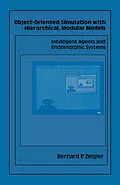Object-Oriented Simulation with Hierarchical, Modular Models: Intelligent Agents and Endomorphic Systems describes an approach to object-oriented discrete event simulation and the concepts of hierarchical, modular model construction, The implementation of the concepts of multifaceted modeling methodology in the DEVS-Scheme modeling and simulation environment is discussed. The use of the DEVS-Scheme environment in modeling artificial intelligent agents is also considered, along with the concept of endomorphism to characterize the application of self-embedded models, including models of self.
Comprised of 15 chapters, this book begins with an overview of the dimensions of knowledge representation in simulation environments, followed by a discussion on object-oriented programming as well as the concepts of modular, hierarchical models and the system entity structure. Subsequent chapters focus on digraph-models and experimental frames; DEVS formalism and DEVS-Scheme simulation environment; a model base for simple multi-computer architectures; and rule-based specification of atomic models. Model bases in endomorphic systems and intelligent agents are also examined.
This monograph will be of interest to simulation theorists as well as practitioners and researchers in the fields of artificial intelligence, systems engineering, computer science and engineering, and operations research.
Autorentext
Bernard P. Zeigler, is a Professor of Electrical & Computer Engineering at the University of Arizona and co-director of the Arizona Center for Integrative Modeling and Simulation. He is the author of numerous books and publications, a Fellow of the IEEE, and of the Society for Modeling and Simulation International.
Zeigler is currently heading a project for the Joint Interoperability Test Command (JITC) where he is leading the design of the future architecture for large distributed simulation events for the Joint Distributed Engineering Plant (JDEP). He is also developing DEVS-methodology approaches for testing mission thread end-to-end interoperability and combat effectiveness of Defense Department acquisitions and transitions to the Global Information Grid with its Service Oriented Architecture (GIG/SOA).
Inhalt
Preface
1 Dimensions of Knowledge Representation in Simulation Environments
1.1 Introduction
1.2 Knowledge Representation Schemes and Formalisms
1.3 Simulation Model Specification Formalisms
1.4 AI Knowledge Representation Schemes
1.5 Representation and Knowledge
1.6 System-Theoretic Representation
1.7 Modular, Hierarchical Models and Object-Oriented Paradigms Contrasted
1.8 Framework for Knowledge Representation in Simulation
1.9 What Kinds of Modelling and Simulation Knowledge Are There?
1.10 Endomorphic Models, Simulations, and Agents
2 Basics
2.1 Object-Oriented Programming Concepts
2.2 The System Entity Structure/Model Base
2.3 Independent Testability
2.4 Artificial Worlds Example
2.5 SES Pruning and Model Synthesis
3 DEVS Formalism and Devs-Scheme
3.1 Discrete Event Dynamic Systems
3.2 Brief Review of the DEVS Formalism
3.3 Basic Models
3.4 Coupled Models
3.5 DEVS-Scheme Simulation Environment
4 Atomic-Models: Simple Processor Example
4.1 Performance of Simple Architectures
4.2 A Simple Processor Model
4.3 Normal Form Atomic Model Specification
4.4 DEVS-Scheme Atomic Model Implementation of Simple Processor
4.5 Simulation of Atomic Models
4.6 Stand-Alone Testing of an Atomic Model
4.7 Simple Processor with Buffering and Random Processing Times
5 Digraph-Models and Experimental Frames
5.1 Experimental Frame for Simple Computer Architectures
5.2 Development of Digraph-Models
5.3 Co-Ordinator of Coupled-Models
5.4 Applicability of Frames to Models: Model Instrumentation
6 A Model Base for Simple Multicomputer Architectures
6.1 Co-Ordinators and Architectures
6.2 Testing the Architectures
7 System Entity Structures
7.1 System Entity Structure Definitions and Axioms
7.2 Using the System Entity Structure in DEVS-Scheme
7.3 System Entity Structure Organization of Model Bases
7.4 Operations on Hierarchical Model Structures: Flatting and Deepening
8 Advanced Devs Concepts and Kernel-Models
8.1 More Advanced Processor Models
8.2 Kernel-Models: Homogeneous Structures
8.3 Example: Parallel Processor Broadcast Architecture
8.4 Methods Make-new and Make-class
8.5 System Entity Structure Representation of Kernel Models
8.6 Multilayered Models and Distributed Experimental Frames
9 Rule-Based Specification of Atomic-Models
9.1 Activities as Rules
9.2 Class Forward-Models
9.3 Inheritance and Specialization
9.4 Specialization and Multiple Entities
9.5 DEVS-Scheme Methodology Reviewed
10 A Robot-Managed Laboratory of the Future
10.1 Multilevel Hierarchical Robot Model
10.2 Space Management for Mobile Components
10.3 Robot Cognition System
10.4 Robot-Managed Laboratory Model
11 Endomorphy: Models within Intelligent Agents
11.1 Approach to Endomorphy: Multifacetted Modelling Methodology
11.2 Process Laboratory Model
11.3 Robot Models: Designing Model-Plan Units
11.4 DEVS Representation of Dynamic Systems
11.5 Obtaining the Characteristic Functions of the DEVS Model
11.6 Robot Fluid Handling MPUs
11.7 Table-Models: Deriving Internal Models from External Models
11.8 Windows in Table-Models: Parameter Sensitivity Analysis
12 Endomorphy: Model Usage within Intelligent Agents
12.1 Event-Based Control
12.2 Using DEVS Models of Processes to Construct Event-Based Control Models
12.3 Introspection and Super-Simulation
12.4 Table-Models: Command Sequence Planning
12.5 Breakdown Diagnosis
12.6 Testing MPU Designs
12.7 Summary: Methodology for Event-Based Control
13 Model Base Management and Endomorphic Systems
13.1 Reuse of Pruned Entity Structures
13.2 Hierarchical Reuse of PES Versions
13.3 Partitioned System Entity Structures
13.4 Context Sensitive Pruning
13.5 Model Coherence and Context Sensitive Constraint Rules
13.6 Model Bases in Endomorphic Systems and Intelligent Agents
13.7 Minsky's Views on Models and Knowledge
14 DEVS-Scheme in the Larger Scheme of Things
14.1 Layers of DEVS-Scheme
14.2 Other Properties, Other Views
15 Epilogue: The Challenge of High Autonomy Systems
A Advanced Concepts and Facilities
A.1 Continuous Model Extensions to DEVS-Scheme
A.2 Simulation of Multi-Formalism Non-Homogeneous Networks
A.3 Distributed Simulation of DEVS Models
A.4 Automated Hierarchical Model Simplification
A.5 Variable Structure Models
A.6 Using Object-Oriented Concepts to Support Extensibility of Layer 1 with Respect to Layer 2
A.7 Converting Non-Modular to Modular Form
B DEVS and GSMP: Some Relations
B.1 Some Simple Behaviors of DEVS
B.2 Proof that the DEVS Behaviors Require Uncountable State Sets
B.3 Expressing GSMP within DEVS
Bibliography
Index
